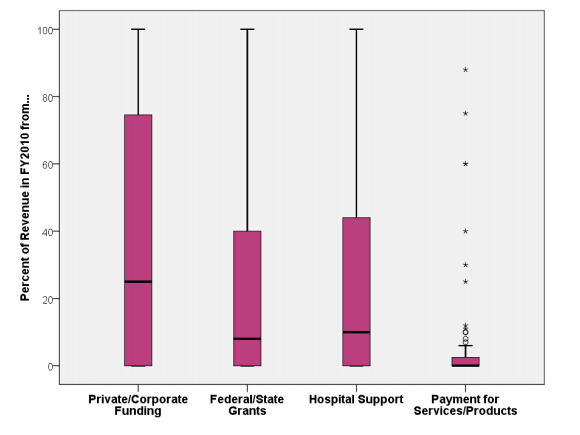|
[1]
|
Hellinger F. (2009) Tax-exempt hospitals and community benefits: a review of state reporting requirements. J Health Polit Policy Law 34(1): 37-61.
|
|
[2]
|
ACHI Community Health Assessment Toolkit. (2014) Available from: http://www. assesstoolkit. org. Accessed July 2, 2014.
|
|
[3]
|
Community Commons. (2014) Available from http://www. communitycommons. org. Accessed Juy 2, 2014.
|
|
[4]
|
Rosenbaum S. (2013) Principles to consider for the implementation of a community health needs assessment process.
|
|
[5]
|
Pressley J, Barlow B, Durkin M, et al. (2005) A national program for injury prevention in children and adolescents: The injury free coalition for kids. J Urban Health 82(3): 389-402.
|
|
[6]
|
7. Children's Safety Network. (2012) Injury prevention: hat works? A summary of costs-outcome analysis for injury prevention programs.
|
|
[7]
|
8. Centers for Disease Control and Prevention. (2012) National action plan for child injury prevention: an agenda to prevent injuries and promote safety of children and adolescents in the United States. Atlanta: National Center for Injury Prevention and Control.
|
|
[8]
|
9. Duncan P, Amy E. (2009) Bright futures for the busy clinical practice: A clinical guide for pediatricians. Adol Health Update 22(1): 1-
|
|
[9]
|
10. Hagan J, Duncan P. (2008) Bright futures: guidelines for health supervision of infants, children and adolescents. Elk Grove Village: American Academy of Pediatrics.
|
|
[10]
|
11. Trauma Programs. (2012) New verification site visit outcomes. Chicago: American College Surgeons.
|
|
[11]
|
12. Kerner J, Rimer B, Emmons K. (2005) Introduction to the special section on dissemination. dissemination research and research dissemination: how can we close the gap. Health Psychol24(5): 443-446.
|
|
[12]
|
13. Glasgow R, Lichtenstein E, Marcus A. (2003) Why don't we see more translation of health promotion research to practice? Rethinking the efficacy-to-effectiveness transition. Am J Public Health 93: 1-1267.
|
|
[13]
|
14. Fixsen DL, Naoom SF, Blase KA, et al. (2005) Implementation research: a synthesis of the literature. Tampa: University of South Florida.
|
|
[14]
|
15. Wandersman A, Duffy J, Plaspohler P, et al. (2008) Bridging the gap between prevention research and practice: The interactive systems framework for dissemination and implementation. Am J Comm Psychol 41: 171-181. doi: 10.1007/s10464-008-9174-z

|
|
[15]
|
16. Aarons GA, Sommerfeld DM, Walrath-Greene CM. (2009) Evidence-based practice implementation: The impact of public versus private sector organization type on organizational support, provider attitudes, and adoption of evidence-based practice. Implem Sci 4(1): 83.
|
|
[16]
|
17. Feldstein AC, Glasgow RE. (2008) A practical, robust implementation and sustainability model (PRISM) for integrating research findings into practice. Jt Comm J Qual Patient Saf 34(4):228-243.
|
|
[17]
|
18. Dobbins M, Hanna S, Ciliska D, et al. (2009) A randomized controlled trial evaluating the impact of knowledge translation and exchange strategies. Implem Sci 4(1): 61.
|
|
[18]
|
19. McCormack B, McCarthy G, Wright J, et al. (2009) Development and testing of the Context Assessment Index (CAI). Worldviews Evidence-based Nurs 6(1): 27-35.
|
|
[19]
|
20. Estabrooks CA, Squires JE, Cummings GG, et al. (2009) Development and assessment of the Alberta Context Tool. BMC Health Serv Res 9(1): 234.
|
|
[20]
|
21. Holt DT, Armenakis AA, Feild HS, et al. (7) Readiness for organizational change: the systematic development of a scale. J Appl Behav Sci 43(2): 232-255.
|
|
[21]
|
22. Jacobs JA, Clayton PF, Dove C, et al. (2012) A survey tool for measuring evidence-based decision making capacity in public health agencies. BMC Health Serv Res 12: 57. doi: 10.1186/1472-6963-12-57

|
|
[22]
|
23. Kajermo KN, Boström AM, Thompson DS, et al. (2010) The BARRIERS scale—the barriers to research utilization scale: A systematic review. Implem Sci 5(1): 32.
|
|
[23]
|
24. Ohman-Strickland PA, John Orzano A, Nutting PA, et al. (2007) Measuring organizational attributes of primary care practices: development of a new instrument. Health Serv Res 42(3 Pt1):1257-1273.
|
|
[24]
|
25. Aarons GA. (2005) Measuring provider attitudes toward evidence-based practice: consideration of organizational context and individual differences. Child Adolesc Psychiatr Clin N Am 14(2):255-271.
|
|
[25]
|
26. PASW STATISTICS 18. 0 Command syntax reference [computer program]. (2011) Chicago: SPSS Inc.
|
|
[26]
|
27. Hanson N. (2011) Defining the children's hospital role in child maltreatment. 2nd ed. Alexandria:National Association of Children's Hospitals and Related Institutions.
|
|
[27]
|
28. Shelton D. (2009) Community health needs assessment survey. Alexandria: National Association of Children's Hospitals and Related Institutions.
|
|
[28]
|
29. Children's Hospital Association. (2012) Survey findings children's hospitals child abuse service. Available from: http://www. childrenshospitals. org.
|















 DownLoad:
DownLoad: